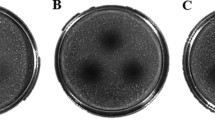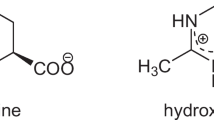Abstract
Halocins are antimicrobial peptides secreted by different members of haloarchaea. Halocin HA4 was purified from Haloferax larsenii HA4 using combination of ultrafiltration and chromatographic techniques. It was found to be ~ 14 kDa with unique N-terminal sequence, H2N-AEEEIFXPDX, which did not show homology with the known sequence suggesting a new/novel compound. It was found to be heat resistant up to 100 °C, stable at pH 2.0–10.0, and retained complete activity in the presence of different organic compounds such as methanol, ethanol, acetone, isopropanol, ethyl acetate, Tween 80, acetonitrile, SDS, Triton X-100, and urea. However, complete activity was reduced after the treatment with trypsin, papain, and proteinase K suggesting proteinaceous nature of the compound. The cytocidal nature of halocin HA4 was evidenced with complete loss of viable count of indicator strain, H. larsenii HA10. The change in FTIR spectrum of halocin-treated cells suggested halocin HA4 interacts with cell membrane and nucleic acids of the target cells. Thus, we report a new halocin inhibitory to related strains and may be applied in the preservation of salted foods and leather hides in the respective industries.




Similar content being viewed by others
Data Availability
Materials described in the manuscript, including all relevant raw data, will be freely available to any researcher wishing to use them for non-commercial purposes, without breaching participant confidentiality.
References
Torreblanca M, Meseguer I, Ventosa A (1994) Production of halocin is a practically universal feature of archaeal halophilic rods. Lett Appl Microbiol 19:201–205. https://doi.org/10.1111/j.1472-765X.1994.tb00943.x
Ghanmi F, Carré-MLouka A, Zarai Z, Mejdoub H, Peduzzi J, Maalej S, Rebuffat S (2020) The extremely halophilic archaeon Halobacterium salinarum ETD5 from the solar saltern of Sfax (Tunisia) produces multiple halocins. Res Microbiol 171(2):80–90. https://doi.org/10.1016/j.resmic.2019.09.003
O’Connor E, Shand R (2002) Halocins and sulfolobicins: the emerging story of archaeal protein and peptide antibiotics. J Ind Microbiol Biotech 28:23–31. https://doi.org/10.1038/sj/jim/7000190
Price LB, Shand RF (2000) Halocin S8: a 36-amino-acid microhalocin from the haloarchaeal strain S8a. J Bacteriol 182(17):4951–4958. https://doi.org/10.1128/JB.182.17.4951-4958.2000
Yadav MK, Kumar V, Singh B, Tiwari SK (2017) Phospholipid/polydiacetylene vesicle-based colorimetric assay for high-throughput screening of bacteriocins and halocins. Appl Biochem Biotechnol 182(1):142–154. https://doi.org/10.1007/s12010-016-2316-0
Meseguer I, Rodriguez-Valera F (1986) Effect of halocin H4 on cells of Halobacterium halobium. J Gen Microbiol 132:3061–3068. https://doi.org/10.1099/00221287-132-11-3061
Torreblanca M, Meseguer I, Rodriguez-Valera F (1989) Halocin H6, a bacteriocin from Haloferax gibbonsii. J Gen Microbiol 135:2655–2661. https://doi.org/10.1099/00221287-135-10-2655
Platas G, Meseguer I, Amils R (2002) Purification and biological characterization of halocin H1 from Haloferax mediterranei M2a. Int Microbiol 5(1):15–19. https://doi.org/10.1007/s10123-002-0053-4
Li Y, Xiang H, Liu J, Zhou M, Tan H (2003) Purification and biological characterization of halocin C8, a novel peptide antibiotic from Halobacterium strain AS7092. Extremophiles 7(5):401–407. https://doi.org/10.1007/s00792-003-0335-6
Pasić L, Velikonja BH, Ulrih NP (2008) Optimization of the culture conditions for the production of a bacteriocin from halophilic archaeon Sech7a. Prep Biochem Biotechnol 38(3):229–245. https://doi.org/10.1080/10826060802164637
Charlesworth J, Burns BP (2016) Extremophilic adaptations and biotechnological applications in diverse environments. AIMS Microbiol 2(3):251–261. https://doi.org/10.3934/microbiol.2016.3.251
Lequerica JL, O’Connor JE, Such L, Alberola A, Meseguer I, Dolz M, Torreblanca M, Moya A, Colom F, Soria B (2006) A halocin acting on Na+/H+ exchanger of haloarchaea as a new type of inhibitor in NHE of mammals. J Physiol Biochem 62(4):253–262. https://doi.org/10.1007/BF03165754
Kumar V, Tiwari SK (2017) Halocin HA1: An archaeocin produced by the haloarchaeon Haloferax larsenii HA1. Process Biochem 61:202–208. https://doi.org/10.1016/j.procbio.2017.06.010
Kumar V, Tiwari SK (2017) Activity-guided separation and characterization of new halocin HA3 from fermented broth of Haloferax larsenii HA3. Extremophiles 21(3):609–621. https://doi.org/10.1007/s00792-017-0930-6
Kaur R, Tiwari SK (2020) Identification and characterization of a halocin-producing haloarchaeon isolated from Pachpadra salt lake. Lett Appl Microbiol 71(6):620–626. https://doi.org/10.1111/lam.13377
De Man Rogosa JC, Sharpe ME (1960) A medium for the cultivation of Lactobacilli. J Appl Bacteriol 23:130–135. https://doi.org/10.1111/j.1365-2672.1960.tb00188.x
Kaur R, Tiwari SK (2016) Isolation, identification and characterization of Pediococcus pentosaceus LB44 and Weissella confusa LM85 for the presence of bacteriocin-like inhibitory substances (BLIS). Microbiology 85:540–547. https://doi.org/10.1134/S0026261716050088
Kaur R, Tiwari SK (2018) Membrane-acting bacteriocin purified from a soil isolate Pediococcus pentosaceus LB44 shows broad host-range. Biochem Biophys Res Commun 498(4):810–816. https://doi.org/10.1016/j.bbrc.2018.03.062
Schägger H (2006) Tricine–SDS-PAGE. Nat Protoc 1:16–22. https://doi.org/10.1038/nprot.2006.4
Bizani D, Motta AS, Morrissy JA, Terra RM, Souto AA, Brandelli A (2005) Antibacterial activity of cerein 8A, a bacteriocin-like peptide produced by Bacillus cereus. Int Microbiol 8(2):125–131
Rampelotto PH (2013) Extremophiles and extreme environments. Life (Basel) 3(3):482–485. https://doi.org/10.3390/life3030482
Rodriguez-Valera F, Juez G, Kushner DJ (1982) Halocins: salt dependent bacteriocins produced by extremely halophilic rods. Can J Microbiol 28:151–154. https://doi.org/10.1139/m82-019
Ghanmi F, Carré-MLouka A, Vandervennet M, Boujelben I, Frikha D, Ayadi H, Peduzzi J, Rebuffat S, Maalej S (2016) Antagonistic interactions and production of halocin antimicrobial peptides among extremely halophilic prokaryotes isolated from the solar saltern of Sfax. Tunisia Extremophiles 20(3):363–374. https://doi.org/10.1007/s00792-016-0827-9
Mazguene S, Rossi M, Gogliettino M, Palmieri G, Cocca E, Mirino S, Imadalou-Idres N, Benallaoua S (2018) Isolation and characterization from solar salterns of North Algeria of a haloarchaeon producing a new halocin. Extremophiles 22(2):259–270. https://doi.org/10.1007/s00792-017-0994-3
Haseltine C, Hill T, Montalvo-Rodriguez R, Kemper SK, Shand RF, Blum P (2001) Secreted euryarchaeal microhalocins kill hyperthermophilic crenarchaea. J Bacteriol 183(1):287–291. https://doi.org/10.1128/JB.183.1.287-291.2001
Filip Z, Hermann S (2001) An attempt to differentiate Pseudomonas spp. and other soil bacteria by FTIR spectroscopy. Eur J Soil Biol 37:137–143. https://doi.org/10.1016/S1164-5563(01)01078-0
Funding
This work was financially supported by the Council of Scientific and Industrial Research, New Delhi (38(1220)/09/EMR-II), and Department of Biotechnology (DBT), Ministry of Science and Technology, New Delhi (BT/PR8306/PID/6/738/2013).
Author information
Authors and Affiliations
Corresponding author
Ethics declarations
Ethical Approval
This article does not contain any studies with human participants or animals performed by any of the authors.
Informed Consent
For this type of study, formal consent is not required.
Conflict of Interest
The authors declare no competing interests.
Additional information
Publisher's Note
Springer Nature remains neutral with regard to jurisdictional claims in published maps and institutional affiliations.
Supplementary Information
Below is the link to the electronic supplementary material.
Rights and permissions
About this article
Cite this article
Kaur, R., Tiwari, S.K. Purification and Characterization of a New Halocin HA4 from Haloferax larsenii HA4 Isolated from a Salt Lake. Probiotics & Antimicro. Prot. 13, 1458–1466 (2021). https://doi.org/10.1007/s12602-021-09823-2
Accepted:
Published:
Issue Date:
DOI: https://doi.org/10.1007/s12602-021-09823-2




